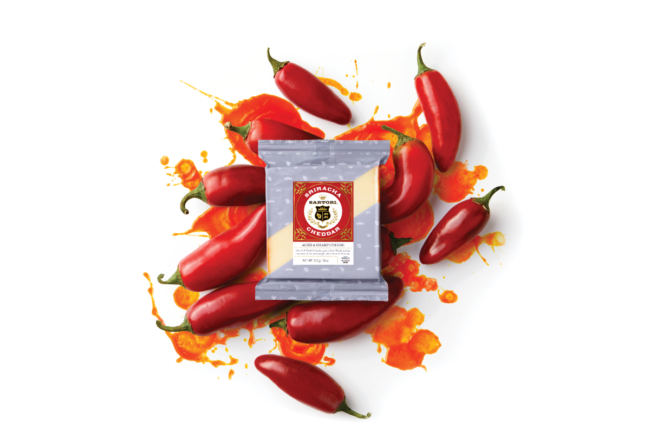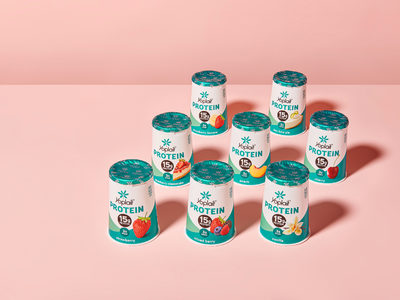Today’s consumers want to know how their food is made, where it comes from and how to create an exciting food experience. Social media encourages users to actively participate and try global cuisines, and dairy processors are leveraging this interest, introducing unique flavors in their products.
International flavors, spiciness, and bold, unusual flavor combinations were identified as emerging trends in Kerry’s 2024 global taste charts, “A World of Future Tastes.”
The taste charts track flavor adoption and evolution around the world and provide a look at ingredients and trends that will affect innovation in the food and beverage industry, according to Kerry. The taste chart is a culmination of a year-long research project that includes a series of charts for 13 individual regional markets.
“The global exchange and dissemination of tastes and flavors through social media and travel is still in its infancy, and globalization in food, beverage and cuisine development make this a truly exciting time to be in the industry,” said Soumya Nair, global consumer research and insights director at Kerry. “Although rapidly changing times can present great challenges, they also provide an unparalleled opportunity for brands to catch an emerging trend on the rise. We are seeing many unique flavor intersections in foods and beverages, and Kerry is using technologies such as natural language processing, AI, social media and traditional consumer observation tools to stay ahead of the adoption curve and to help customers navigate the emerging taste environment for products being developed in 2024.”
For dairy, consumer tendencies involve both tradition and innovation, with “flavor frenzy” being identified as a key consumer trend in a report from the Dairy Farmers of Wisconsin (DFW) which outlined trends that are expected to impact the food industry.
Suzanne Fanning, DFW senior vice president and chief marketing officer for Wisconsin Cheese, said the world’s most successful businesses “truly understand” consumers.
“What people care about and what drives them should always be top of mind for marketers,” Fanning said. “That’s why we constantly ask questions, review data and learn as much as possible.”
 Photo: Sartori Cheese
Photo: Sartori Cheese Product development
With evolving consumer taste preferences, dairy processors have to assess their offerings and decide when to make adjustments.
At Sargento, Plymouth, Wis., the company recognized that consumers were seeking more convenient choices that delivered flavorful options.
“Our teams uncovered this consumer insight years ago, well before mainstream media and leaders were discussing it and continue to keep track of how consumers’ needs are evolving,” said Kristi Jankowski, executive vice president of innovation for Sargento. “However, when talking popular flavor trends, we may be innovators, but at our core we’re family-owned and we live for the decades, not the fiscal quarters. Because of this, we are all about keeping a long-term view of our business. While other businesses may operate in the short term space, Sargento focuses on the long term. This forward thinking keeps us competitive, as we encourage our teams across the company to always be creating new ideas and collaborating with one another.”
Sargento has a dedicated innovation team which prioritizes creating new products and innovating. Jankowski said the company encourages employees to apply for patent developments, which improves processes and the pipeline of products. But innovation takes time.
“Timing varies product by product, flavor by flavor,” Jankowski said. “Our products are natural, and they age naturally, so we can’t rush through timelines and manufacture a flavor – it has to develop over time.”
The process helped the company introduce its latest string cheese offerings, Fiesta Pepper and Smokehouse, which reflect the desire from consumers for new, bolder food experiences.
“Bringing smoky, rich, hickory flavors – our Smokehouse String Cheese – as well as the heat from the Fiesta Pepper String Cheese further answers the call for more variety, convenience, fun and wholesome natural cheese for consumers,” Jankowski said.
Other dairy processors are following suit.
Kraft Heinz, Chicago, introduced new flavors to join its Kraft Singles product line for the first time in close to 10 years, debuting Jalapeño, Garlic & Herb, and Caramelized Onion options.
The brand said the three new flavors highlight its “commitment to innovating and meeting consumer demands.”
Organic Valley, La Farge, Wis., revealed that it prioritized distinctive tastes when developing its newest premium cheese line, Flavor Favorites.
The cooperative’s new crafted cheeses launched in four options: Italian Herb Mozzarella Shreds, Spicy Cheddar Shreds, Spicy Cheddar Slices and Smoky Cheddar Slices.
“People are looking for fast and easy ways to add excitement to their dinner tables,” said Laurie Drake, Organic Valley vice president of marketing. “We hope that our new Organic Valley Flavor Favorites cheeses will inspire consumers because it empowers them with the flavor power to elevate meals like pizza night, taco night and burger night, all with a clean label they can feel good about.”
The company described its Italian Herb Mozzarella Shred as “basil forward with a background of garlic and herbal zest complementing the clean, creamy mozzarella base.” The Spicy Cheddar shreds and slices, meanwhile, feature habanero and paprika.
Saputo Cheese USA Inc., Milwaukee, leveraged consumer interest in bold tastes with the launch of its Stella Rubbed Fontinella Wedges. The cheese is hand-rubbed to create four unique flavor combinations — Basil Pesto, Harrissa, Bourbonista and Black Pepper.
 Image: Organic Valley
Image: Organic ValleyExtra spicy
Consumers are continuing to turn up the heat in dishes by adding spice to everyday foods, Kerry said. Spicy ingredients may include arbol peppers, gochugaru and tajin seasonings. Whether described as zesty or “with a kick,” these flavors are taking center stage in different types of food and beverage applications as consumers seek new ways to spice up food.
Chili peppers present an opportunity for all types of flavor creations, as they are associated with the most popular international influences in the food industry. Chilies get their heat from capsicum, a crystalline chemical compound that stimulates nerve endings in the mouth and skin and range in heat levels. The guajillo and aji panaca have the least amount of heat on the Scoville scale, while the Bhut Jolokia, also known as the ghost pepper, is recognized as the hottest pepper in the world.
Market researcher Datassential, Chicago, said demand for spicy foods has also grown in the foodservice segment, where 71% of menus and 11% of drink menus feature the word “spicy.” In fact, during the first half of 2023, there were 270 spicy limited-time offerings introduced by major foodservice chains.
Tajin — the dried seasoning blend of chilis, salt and lime — has grown the most over the past four years across all foodservice categories, according to Datassential. It’s also gaining traction in retail. Century Snacks, Commerce, Calif., for example, now offers Snak Club Tajin Gummy Bears. The gummies come in apple, lemon, orange, pineapple and strawberry flavors that are all sprinkled with Tajin seasoning.
Nashville hot, spicy margarita and mango habanero flavors also saw triple-digit increases during the same period, according to Datassential. Popular pepper ingredient additions include pickled jalapeños, ghost peppers, habanero peppers and Calabrian chili peppers.
Dairy products — butter, cheese, ice cream and even yogurt, as well as condiments made with dairy fat — are ideal carriers for chilies. That’s because the capsicum in the chilies is soluble in fat, so it is more easily dispersed in a fat-based system, preventing a fiery strike with linger.
“Dairy fats help counteract the heat of spicy compounds,” said Whitney Beem, marketing and insights director at Parker Food Group. “While still relatively in early stages of adoption, spicy flavors in ice cream are driving interest in restaurants. What about a jalapeño-lime swirl in a cream cheese spread or a spiced honey nut yogurt parfait using hot honey glazed pecans? A habanero-infused butter makes a great fiery seafood topping.”
Golden opportunity
Several flavor companies and market researchers have tagged Indian cuisine and the flavors associated with it as key trends in 2024. Recent news around golden milk indicates the trend may be gaining momentum.
All of these flavors are taking center stage in different types of food and beverage applications as consumers seek new ways to spice up their lives.
Golden milk is an Indian beverage known as haldi doodh, which is non-caffeinated and has a bright gold color. The color is the result of adding yellow turmeric into traditional dairy milk. Historically served warm, and often as a nighttime beverage, modern versions include iced lattes and smoothies, with or without other such spices as cardamon, cinnamon or ginger, and some kind of sweetener like honey. The beverage also may be referred to as turmeric milk to emphasize the addition of the ayurvedic plant-based ingredient.
That’s what it’s called at McDonald’s Corp.’s new CosMc’s concept. The small-format, beverage-led business’ menu offers turmeric spiced lattes in iced and hot varieties, with a choice of dairy milk or an alternative milk. CosMc’s menu is focused on beverage exploration, with bold and unexpected flavor combinations, vibrant colors and functional boosts. It’s also helping to take turmeric mainstream.
Turmeric powder has a black pepper-like flavor with an earthy, mustard-like aroma. It has been used in Indian culture for centuries as a remedy for the common cold, inflammation and an upset stomach. It functions as an antioxidant due to the presence of curcumin and is associated with immunity and improving overall health.
“Although global flavors are trending across the board, there are a few that stand out as the most sought after by consumers right now,” said Shannon Cushen, director of marketing, Fuchs North America, Hampstead, Md. “Flavors inspired by Indian cuisine, for example, have been trending due to a variety of factors. First of all, Indian cuisine has been becoming more mainstream, making it approachable and less intimidating to consumers who aren’t so adventurous. At the same time, however, Indian cuisine is more exotic than other mainstream global cuisines, which is appealing to adventurous consumers.
“Additionally, Indian cuisine features complex spicy flavor profiles, vibrant colors, plant-based ingredients and spices — like turmeric — that are trending for their potential health benefits, all of which are popular with consumers.”
— Donna Berry contributed to this story.



